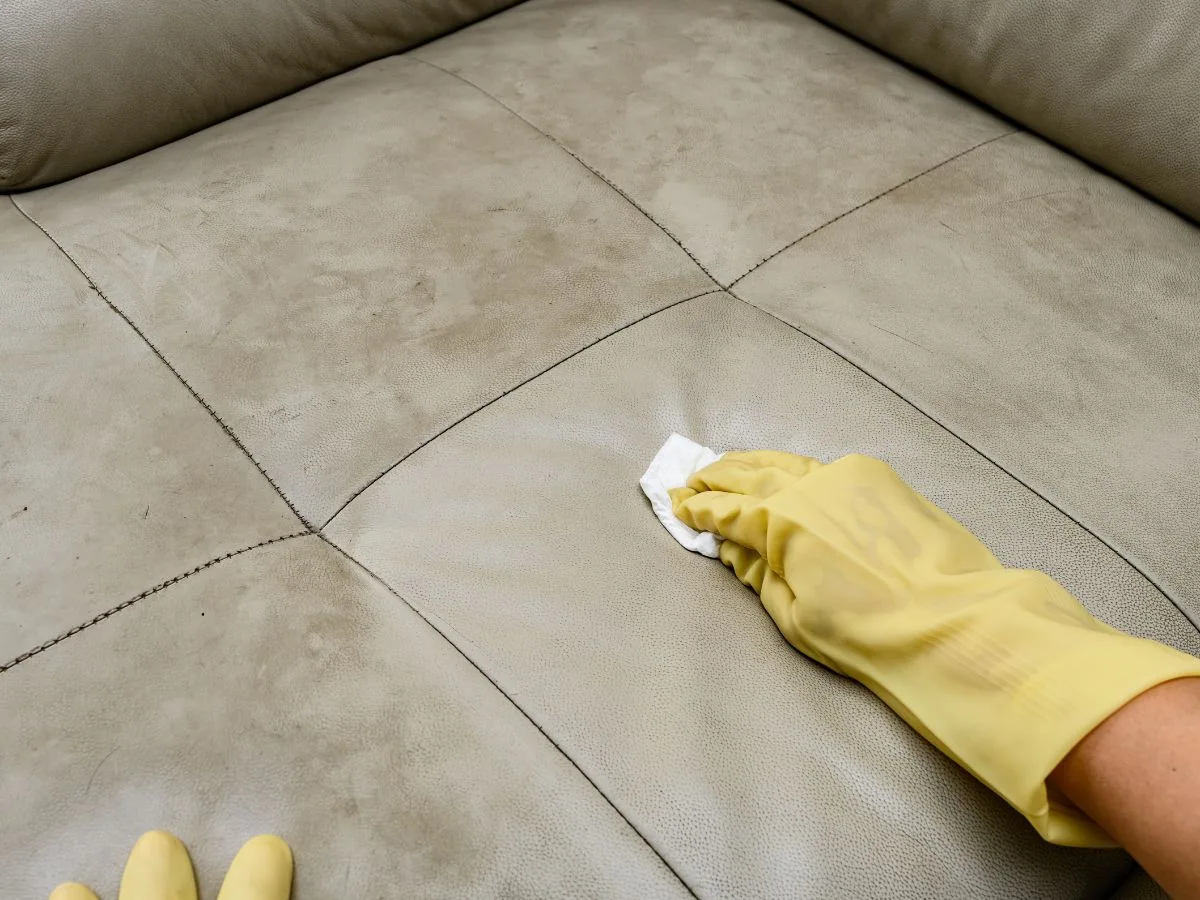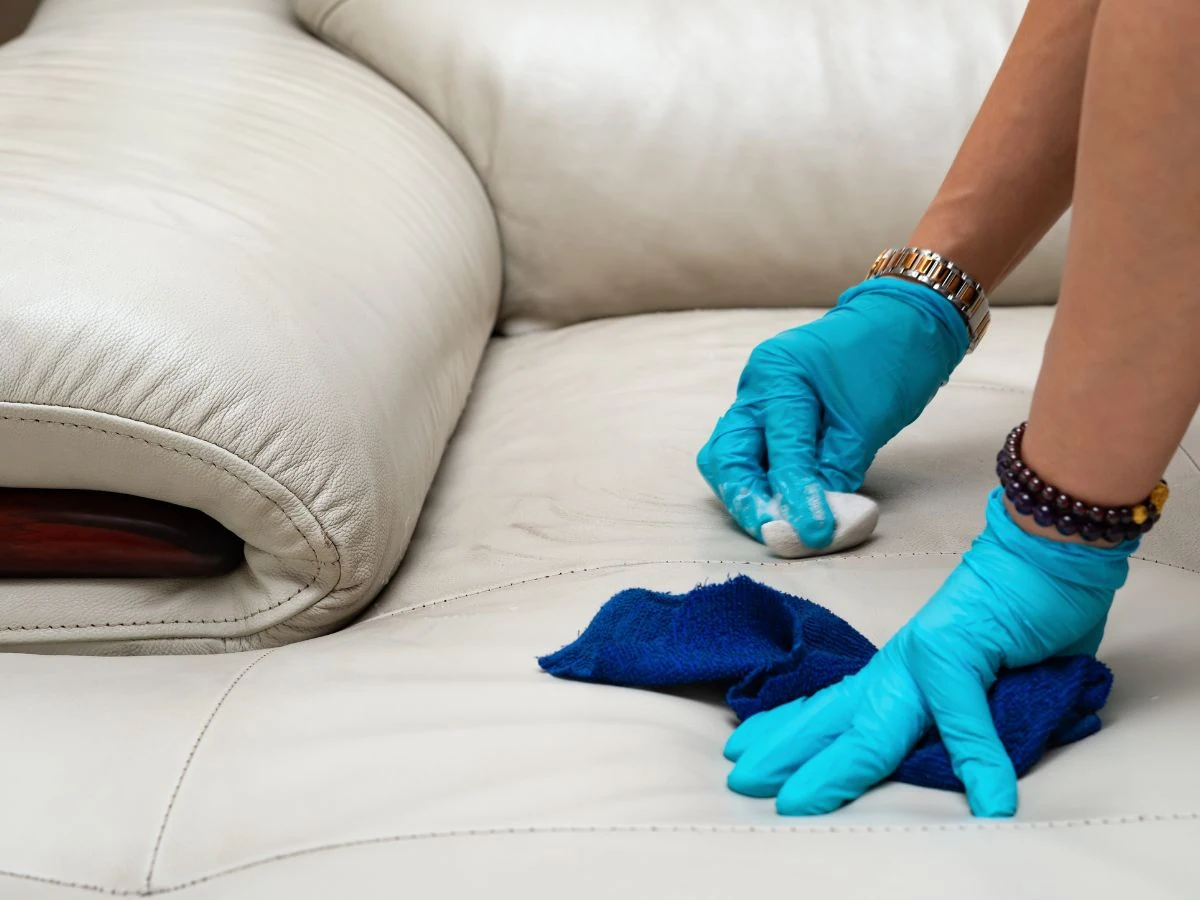Don’t Risk It: Why Leather Sofa Cleaning Is Best Left to the Experts
Leather sofas represent a significant investment in both comfort and style. When stains appear or the leather begins to look dull, the temptation to tackle the cleaning yourself can be strong. However, leather sofa cleaning requires specialised knowledge and techniques that most homeowners simply don’t possess. One wrong move with the wrong product can result in permanent discolouration, cracking, or even complete ruin of your cherished furniture piece.
Professional leather cleaning isn’t just about removing dirt and stains-it’s about understanding the complex nature of different leather types, using appropriate cleaning methods, and applying the right conditioning treatments to preserve the material’s integrity.
Understanding Different Types of Leather
Not all leather is created equal, and this fundamental truth lies at the heart of why professional cleaning is so crucial. The three main types of leather used in furniture manufacturing, and leather upholstery such as chairs and footstools, each require distinctly different care approaches, and misidentifying your leather type can lead to irreversible damage.
Aniline leather represents the most natural and luxurious option, treated only with transparent dyes that allow the natural grain and markings to show through. This type of leather is highly absorbent and particularly vulnerable to staining and water damage. Semi-aniline leather offers a middle ground, featuring a light protective coating that provides some stain resistance whilst maintaining much of the natural appearance. Pigmented leather, the most durable option, has a polymer surface coating that makes it highly resistant to stains and fading but requires specific cleaning products to avoid damaging the protective layer.
Pre-Cleaning Preparation: The Foundation of Safe Leather Care
Before you begin the cleaning process, setting the stage for safe and effective leather care is essential. Start by clearing your leather sofa of any loose items remove cushions, throws, and any personal belongings to ensure nothing gets in the way or suffers accidental damage. Take a moment to inspect your sofa for stains, spills, or areas showing signs of wear and tear. This is also the perfect time to identify whether your sofa is made from real leather, faux leather, or a combination of both, as each material requires a different cleaning approach. For example, a brown leather sofa may need a cleaner specifically designed to preserve its rich colour and supple texture, while faux leathers often benefit from gentler products.
“If you’re unsure about your sofa’s material, consult the manufacturer’s instructions or reach out to a professional for guidance. Once you know what you’re working with, gather your cleaning supplies: a soft brush attachment for your vacuum to remove surface dust without scratching, a clean cloth for gentle wiping, and a leather care kit tailored to your sofa’s specific needs.
While preparing your cleaning supplies, it’s also wise to inspect your sofa for any existing damage such as scratches or scuffs. If you discover scratches during your inspection, learn how to fix scratches on leather sofas before proceeding with your cleaning routine, as addressing these issues first will ensure a more uniform and professional-looking result. Taking these preparatory steps ensures that your cleaning process is both safe and effective, helping to maintain the beauty and longevity of your leather sofa.
Essential Professional Cleaning Techniques
Professional leather cleaning follows a systematic approach that begins with thorough assessment and testing. Expert cleaners first identify the leather type, assess the extent of soiling or damage, and test a particular product designed for the specific type of leather on inconspicuous areas to ensure compatibility. This methodical approach prevents the trial-and-error mistakes that often plague DIY cleaning attempts.
The cleaning process typically begins with careful vacuuming to remove dust and surface dirt and debris without scratching the leather. Professional-grade equipment allows for gentle suction that won’t damage delicate surfaces. Next, a leather cleaner specifically formulated to clean leather surfaces safely is applied using techniques that vary based on the leather type and soil level. Understanding the best way to clean leather sofas helps explain why these specific techniques and product formulations are so crucial for maintaining leather integrity.
Advanced Stain Removal Techniques
Different types of stains require specific removal approaches, and this is where professional expertise becomes invaluable. Ink stains, one of the most challenging issues homeowners face, require immediate attention with specialised solvents that can break down ink compounds without spreading the stain further. Professionals are trained to remove stains from leather using methods tailored to the type and severity of the stain. Professionals use blotting techniques and specific chemical formulations that most consumers cannot access.
Food and beverage stains present their own unique challenges, particularly when they involve oils, sugars, or acidic components. Grease-based stains require different treatment than water-based spills, and professionals understand how to neutralise acidic substances that can permanently alter leather’s pH balance. The key lies in addressing both the visible stain and any underlying damage to the leather’s structure.
Oil-based stains often penetrate deeply into leather fibres, requiring specialised extraction techniques. Professional cleaners use controlled heat application and specific solvents to draw oils out of the leather without causing heat damage. They also understand when a stain has penetrated too deeply for complete removal, allowing them to recommend recolouring options that can restore the leather’s appearance. These advanced restoration techniques demonstrate the key benefits of professional furniture restoration, which go far beyond basic cleaning to include comprehensive repair and refinishing services.
The timing of stain treatment is critical, and professionals often achieve better results even on old stains because they understand how different substances interact with leather over time. They can assess whether a stain has caused permanent chemical changes to the leather and recommend appropriate restoration techniques.
Cleaning Delicate Areas: Where DIY Goes Wrong
Delicate areas of your leather sofa, such as the seat cushion, armrests, and seams, require extra care during cleaning to avoid accidental damage. Many DIY attempts go awry when harsh chemicals, abrasive cleaners, or too much water are used, stripping away the leather’s natural oils and leading to cracking, fading, or even permanent staining. Instead, always opt for a soft, clean cloth and a gentle cleaning product specifically designed for leather such as a leather cleaning wipe or a nourishing leather protection cream.
When tackling stains or dirt on these sensitive spots, gently blot the area rather than rubbing, working from the outside in to prevent spreading the stain. For stubborn marks, a high-quality leather conditioner can help restore lost moisture and keep the leather soft and resilient. Remember, excessive water is never your friend when cleaning leather; it can seep into the material and cause lasting damage.
The Role of Cleaning Products in Leather Care
The cleaning products you choose play a pivotal role in maintaining the health and appearance of your leather sofa. Not all cleaners are created equal using the wrong product can damage the leather, strip away its natural oils, or leave it dry and prone to cracking. For best results, select a cleaner that is specifically designed for your type of leather, whether it’s natural leather, pigmented leather, or faux leather. Avoid any cleaning products that contain harsh chemicals or abrasive ingredients, as these can do more harm than good.
Gentle, pH-neutral cleaners are ideal for removing dirt, stains, and spills while preserving the leather’s natural oils. Popular options include leather cleaning wipes for quick touch-ups, leather protection cream for ongoing care, and leather conditioner to keep the material supple and hydrated. Always read the label and follow the manufacturer’s instructions to ensure you’re using the product safely and effectively. Professional Maintenance and Care Strategies
Conditioning represents a critical component of professional leather care that many homeowners overlook or perform incorrectly. Professional-grade leather conditioners are formulated to penetrate the leather structure and replenish natural oils without leaving residue or altering the surface texture. The application technique is equally important-professionals understand how much conditioner to use, how to apply it evenly, and how long to allow for proper absorption. Applying leather conditioner in circular motions ensures even coverage and helps protect the fine texture of the leather. The conditioner creates a protective seal on the surface, safeguarding the leather from stains and dirt.
Protection and Warranty: Safeguarding Your Investment
Protecting your leather sofa is about more than just cleaning-it’s about taking proactive steps to preserve its value and appearance for years to come. Regularly applying a leather protection cream or leather conditioner helps to repel stains and spills, while also keeping the leather moisturized and resistant to everyday wear and tear. Investing in a leather care kit specifically designed for your type of leather furniture can make ongoing maintenance simple and effective, especially for a new sofa that you want to keep looking pristine. Following a structured approach to leather furniture maintenance ensures you’re using the right products at the right intervals, maximizing both protection and longevity. This systematic care routine becomes even more valuable when combined with professional services.
For added peace of mind, consider purchasing a warranty or protection plan that covers accidental damage, such as spills, stains, and even general wear and tear. Look for plans that are tailored to leather furniture and include comprehensive coverage, including professional cleaning and maintenance services. Many reputable companies offer leather care kits and protection plans that help you safeguard your investment and enjoy your sofa for many years. By combining regular care with the right protection, you can ensure your leather sofa remains a centrepiece of comfort and style in your home.
Why Choose Professional Leather Care Services
LeatherXpert’s three decades of experience in leather restoration demonstrates the value of professional expertise in maintaining and restoring leather furniture. Their eco-friendly approach ensures that cleaning and restoration processes are safe for families and pets whilst delivering superior results that preserve the leather’s natural beauty and extend its lifespan.
Professional services also provide peace of mind through expertise and accountability. When you attempt DIY leather cleaning, you assume all risk for potential damage. Professional cleaners carry insurance and have the experience to handle unexpected situations that might arise during the cleaning process. They can also identify potential problems before they become serious issues, potentially saving you significant replacement costs.
Conclusion
Leather sofa cleaning involves far more complexity than most homeowners realise, from identifying leather types to selecting appropriate cleaning methods and products. The risks associated with DIY cleaning including permanent staining, cracking, and texture damage far outweigh the potential savings. Professional leather cleaning services bring specialised knowledge, proper equipment, and proven techniques that ensure your leather furniture receives the care it deserves.
The investment in professional leather cleaning pays dividends in extended furniture life, maintained appearance, and preserved value. Rather than risking damage to your valuable leather furniture, trust the expertise of professionals who understand the intricacies of leather care and restoration. If you do clean leather at home, always use a damp cloth (not wet) for gentle cleaning and follow up with a dry cloth to remove any excess moisture and prevent damage.
Ready to give your leather furniture the expert care it deserves? Request a quote from LeatherXpert today and discover how professional leather cleaning can restore and protect your investment for years to come.



